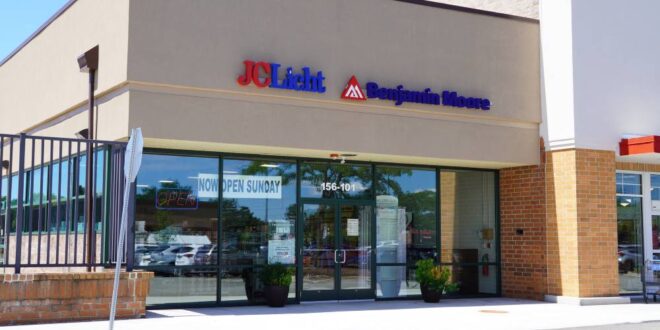This is one of a series of case studies into why training is important and the tangible results it can have on your business. Click Here to read other case studies.
Paint and decorating retailer JC Licht needed a better way to onboard and integrate new employees so they would quickly become productive members of the sales team. However, coordinating training for a few hundred employees would be a daunting task without a plan to use resources wisely and efficiently. Recruitment and development manager Kyle Slagell, along with members of the leadership team at the company, developed a program where each employee has clear expectations for onboarding and continued training support throughout their career. Turnover rates have dropped as employee engagement rates have risen, making training at JC Licht a winning strategy with clear benefits for the company.
The Challenges
Before 2021, there was not a comprehensive strategy for integrating new employees at JC Licht into the workplace quickly. Existing employees often saw new hires as liabilities rather than assets. There was a perception that it would take a while before they could contribute to the team. After a promotion that put him in charge of training for the entire company, Kyle Slagell needed to get an onboarding process up and running smoothly. He also needed to streamline the process so it would be easy to manage and so he could demonstrate a return on the investment in training the company was making.
The Solution
JC Licht operates 66 paint and decorating stores in the Chicago area, with approximately 505 employees. Slagell started out working in JC Licht’s stores as a sales associate, warehouse manager and eventually store manager where he learned the business and lived out JC Licht’s Core Values. Those experiences set him up well to move to his next position where he would oversee training. Today, as recruitment and development manager, Slagell is responsible for coordinating training with all of the store managers and making sure each employee is getting the appropriate training they need to be successful on the job. The program includes an onboarding process where new hires can quickly become assets to the team.
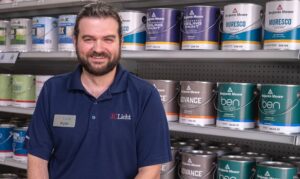
Each new employee works through the company’s New Hire Training Schedule, which combines job shadowing, online learning and in-store activities. The 4-week schedule consists of a checklist of activities each person must complete. At the end of each week, the new employee has a check-in session with their manager or trainer to measure progress and answer any questions or concerns that may have come up over the past week.
Managers have the responsibility of reviewing the checklist and deciding who on their staff would be the best person to train the new hire on a particular task. Managers then sign off when the activity is complete. For example, one task on the list requires the new employee complete three sales transactions, unassisted.
For best results, Slagell mixes up the training methods to suit a variety of learning styles. The company has a training room at its headquarters for group sessions and a learning management system (LMS) for online learning.
“Everyone learns differently, whether it’s classes in person or online,” he says. “We find younger people tend to gravitate towards online learning. We also found that, this past year, 83% of our training was accessed on mobile devices. Most people find it’s easier to access it that way than on a laptop.”
Despite having a month-long onboarding process, Slagell says the company’s goal is to get new hires productive as soon as possible.
“It’s been easy in the past for other employees to see new hires as in the way rather than being there to help,” he says. “We’ve arranged our onboarding in such a way that even after the first week, we can delegate basic tasks to them so they become a valued part of the team right away.”
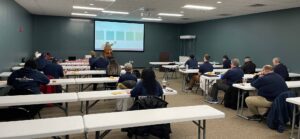
Since they have multiple locations, JC Licht designates a single store per region they can use as training locations. These locations are chosen based on the skill and commitment of the manager to the employee development process. In fact, many of these managers were instrumental in helping Slagell create the training materials. New hires will go to these locations specifically to be trained, he says, helping them get acclimated to the work environment before moving to the store where they’ll eventually be assigned. Having a training store means staff there will be tuned in to the needs of a new employee and able to take the time for training that might not happen at another location.
After the first month, the training becomes more specialized, he says. Managers will look at the new hire’s strengths, find the best fit for them in the company, then seek out the appropriate training. It’s often the time when employees get vendor specific training as appropriate.
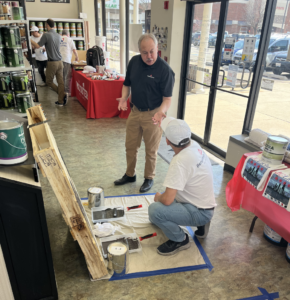
Maximizing Resources
One objection some retailers may have to training is the cost, in both time and money. The first concern is often finding the right person, with enough time, to coordinate training, and it’s the same concern with the same answers that apply whether that person will be overseeing a dozen employees or a few hundred spread across multiple locations.
As Slagell discovered, coordinating training may be easier than you think. The secret lies in finding and learning how to use the resources already available to you.
“When I first took the job as training coordinator, I was initially overwhelmed, thinking we had nothing to work with and would have to start from scratch,” he says. “But there’s so many resources already out there, you just need to take the time to make it work for you. Know the tools you already have at your disposal and how to use them.”
One of their “secret weapons,” says Slagell, is leveraging vendor expertise. By collaborating with their trusted vendors, JC Licht ensures their employees gain in-depth product knowledge and hands-on experience directly from the source. From paint and coatings specialists to equipment manufacturers, vendors provide tailored training sessions, demonstrations and resources that keep the team informed and confident.

Another example of a resource he was able to leverage was the LMS the company had chosen to use. The system had a lot of functions he could automate, reducing the amount of time he needed to spend on training and allowing him to spend more time recruiting.
“We calculated we saved roughly $66,000 in labor just by automating our training and policy process through Paylocity, our LMS and HR system,” he says. “I don’t have to be as hands-on with some of the training as I used to be.”
He uses the courses available from NHPA to teach product knowledge, selling skills and other retail best practices. He also makes use of the free training vendors are able to provide. Both of these resources significantly reduce the amount of training materials he needs to create on his own.
Adding Humor
When he does create company specific training, Slagell works to combat another common perception – training can be boring. As someone with a background in comedy and improvisation, Slagell understands the power of a little levity. He finds ways to incorporate humor whether it’s to break up long orientation sessions, in online learning modules or during in-person sales presentations.
“Some people might see training as repetitive and dull, so I work hard to make the experience entertaining and engaging. I find that humor breaks down some barriers, helps create a more relaxed environment and makes the training more memorable. When trainees are amused and enjoying themselves, they are far more receptive to new information and retain what they learn better. We’ve had a lot of positive feedback for taking the time to keep training fun.”
For example, during their onboarding, new hires will spend a full day at company headquarters. That can be a long day, so Slagell finds ways to interject some humor. During the product knowledge training, one crowd favorite is a YouTube video of a Saturday Night Live sketch about Farrow & Ball, one of JC Licht’s key vendors. A “forklift fails” video serves the dual purpose of illustrating safety protocols in a way that captures the student’s attention. Also throughout the day, students have regular check-ins with questions covering what they’ve learned for the day, as well as a few out-of-context, humorous questions such as “Can humans sneeze in their sleep?”.
“Adding in unexpected humor keeps energy levels high and ensures focus,” he says. “At the end of every orientation, we collect feedback and one of the most consistent responses is how people appreciate the humor. Some of them say that while they’ve been to orientations at other companies that are dull and uninspiring, this time they left invigorating and ready to get started.”
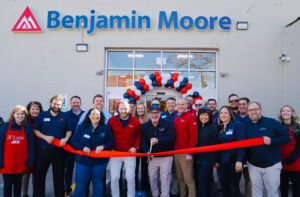 The Results
The Results
With three years to reflect on, Slagell can see clear signs that the training is paying off. Training can get employees more engaged and confident in their sales skills, and as a result they want to stay around longer. Since 2022, turnover rate at JC Licht has dropped 8.6% over previous years.
The company also sends out periodic employee engagement surveys. In a recent survey, Slagell says there were many positive reactions surrounding training. He’s made an effort to keep open lines of communication so if an employee has areas where they want to grow with additional training, they get the opportunity.
“We keep our training flexible so people can put in a request if they have a specific need for training or want to learn a new skill. We set them up to do that,” he says.
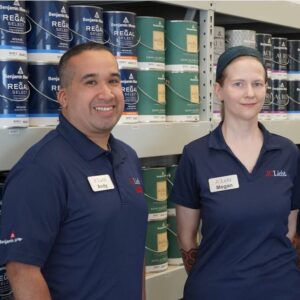 Having an open line of communication also improves the overall training process, Slagell says. He finds that new hires can provide a valuable outside perspective. He asks them questions about how the training is working for them or how it could be improved.
Having an open line of communication also improves the overall training process, Slagell says. He finds that new hires can provide a valuable outside perspective. He asks them questions about how the training is working for them or how it could be improved.
“Getting that feedback is really valuable because you want to know from the people learning it if it’s working or not,” he says. “Be flexible, don’t assume you know what people need or how it’s going to work for them.”
 Hardware Retailing The Industry's Source for Insights and Information
Hardware Retailing The Industry's Source for Insights and Information

